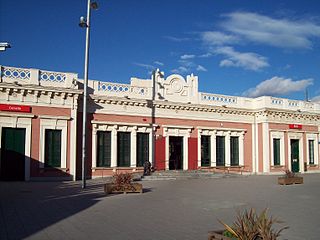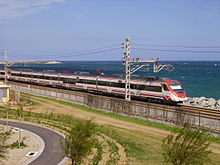
Ferrocarrils de la Generalitat de Catalunya, or FGC, is a railway company which operates several unconnected lines in Catalonia, Spain.

Cornellà Centre, also simply known as Cornellà, is a Rodalies de Catalunya and Barcelona Metro station, as well as Trambaix tram stop. It is located in the city centre of the Cornellà de Llobregat municipality, to the south-west of Barcelona, in Catalonia, Spain.

Barcelona El Clot is a Rodalies de Catalunya station in El Camp de l'Arpa del Clot, in the Sant Martí district of Barcelona in Catalonia, Spain. It is served by Barcelona commuter rail service lines R1, R2 and R2 Nord, as well as Girona commuter rail service line RG1 and regional line R11. Passengers can commute here to Barcelona Metro station Clot. Like its metro counterpart, the station is completely underground, under Carrer d'Aragó and Avinguda Meridiana.

The R2 is a line of Rodalies de Catalunya's Barcelona commuter rail service, operated by Renfe Operadora. It is a major north–south axis in the Barcelona metropolitan area, running from the southern limits of the province of Girona to the northern limits of the province of Tarragona, via Barcelona. North of Barcelona, the line uses the Barcelona–Cerbère railway, running inland through the Vallès Oriental region. South of Barcelona, it uses the conventional Madrid–Barcelona railway, running along the coast through the Garraf region. The R2 had an annual ridership of 33.6 million in 2016, achieving an average weekday ridership of 125,948 according to 2008 data, which makes it the busiest line of the Barcelona commuter rail service.

The R3 is a line of Rodalies de Catalunya's Barcelona commuter rail service, operated by Renfe Operadora. It runs northwards from the Barcelona area to the French border town of Latour-de-Carol, passing through the Vallès Oriental, Osona and Ripollès regions. With a total line length of 165.9 kilometres (103.1 mi), it extends notably beyond the limits of the Barcelona metropolitan area, reaching the Pyrenees mountains. According to 2008 data, the line's average weekday ridership is 22,841.

The R4 is a line of Rodalies de Catalunya's Barcelona commuter rail service, operated by Renfe Operadora. It runs northwards from the northern limits of the province of Tarragona to Barcelona, passing through the inland Alt Penedès region. The line then continues towards central Catalonia, describing a U-shaped route through the Barcelona area. According to 2008 data, the line's average weekday ridership is 105,935, the highest on any line of the Barcelona commuter rail service after the R2.

The R7 is a line of Rodalies de Catalunya's Barcelona commuter rail service, operated by Renfe Operadora. It links Sant Andreu Arenal railway station in northern Barcelona with Cerdanyola Universitat railway station, which serves the Bellaterra campus of the Autonomous University of Barcelona. The R7 shares tracks for most of its length with Barcelona commuter rail service lines R3 and R4, as well as regional rail line R12. According to 2010 data, the line's average weekday ridership is 8,140.
The R10 was a line of Rodalies de Catalunya's Barcelona commuter rail service, operated by Renfe Operadora. It linked half-hourly Barcelona–El Prat Airport with Barcelona's Estació de França, using the Aragó Tunnel through central Barcelona, calling at Sants and Passeig de Gràcia stations. R10 services spanned 22 kilometres (14 mi) of railway lines and six stations. At the time it suspended services, the trains used on the line were Civia electrical multiple units (EMU).

Airport T2 is both a Rodalies de Catalunya commuter rail station and a Barcelona Metro station serving terminal complex T2 of Barcelona–El Prat Airport. They are located adjacent to the airport's terminal T2B, in the municipality of El Prat de Llobregat, to the southwest of Barcelona, in Catalonia, Spain. The Rodalies de Catalunya station is the southern terminus of the current rail link coming from El Prat de Llobregat railway station. It is operated by Renfe Operadora and is served by Barcelona commuter rail service line R2 Nord. The metro station is on the airport branch of Barcelona Metro line 9 (L9) and is operated by Transports Metropolitans de Barcelona (TMB).

Rail transport in Catalonia operates on three rail gauges and services are operated by a variety of public operators:

Rodalies de Catalunya is the main commuter and regional rail system in the Spanish autonomous community of Catalonia. It is administered by the Government of Catalonia and operated by the national rail operator Renfe Operadora. The system consists of 17 service lines chiefly centred in the Barcelona area, serving a total of 203 stations throughout Catalonia, with an average number of 1,000 trains running on it every day. In 2016, it had an annual ridership of 117 million.

Maçanet-Massanes is a Rodalies de Catalunya open triangular railway station serving Maçanet de la Selva and Massanes, in Catalonia, Spain. It is located at the junction where the railway coming from Barcelona via Mataró converges with the Barcelona–Cerbère railway, lying about 5 and 1.9 kilometres away from the urban centers of Maçanet de la Selva and Massanes, respectively. On the Barcelona–Cerbère railway, the station is between Hostalric and Sils, and it is the northern terminus of the railway coming from Mataró.

Figueres is a railway station serving the city of Figueres in Catalonia, Spain. It is on the Barcelona–Cerbère railway and is owned by Adif. The station is served by Rodalies de Catalunya regional line R11 and Girona commuter rail service line RG1.

The R8 is a line of Rodalies de Catalunya's Barcelona commuter rail service, operated by Renfe Operadora. It runs hourly between Martorell and Granollers across the Vallès Occidental region, spanning 40 kilometres (25 mi) and eight stations. The R8 primarily uses the Castellbisbal–Mollet-Sant Fost railway, as well as the Sant Vicenç de Calders–Vilafranca del Penedès–Barcelona and Barcelona–Cerbère railways on its southern and northern ends, respectively. It is currently the only line of the Barcelona commuter rail service entirely bypassing Barcelona. The trains operating on the line are Civia electrical multiple units (EMU).

Sant Adrià de Besòs and Estació de Sant Adrià are a Rodalies de Catalunya commuter rail station and a Trambesòs tram stop, respectively, together forming an interchange station complex in Sant Adrià de Besòs, to the north-east of Barcelona, in Catalonia, Spain. The Rodalies de Catalunya station is on the Barcelona to Maçanet-Massanes via Mataró railway, between Barcelona El Clot-Aragó and Badalona. It is operated by Renfe Operadora and is served by Barcelona commuter rail service line R1 and Girona commuter rail service line RG1. The Trambesòs stop is the northern terminus of routes T4 and T6 and is operated by TRAM.

The R11 is a line of Rodalies de Catalunya's regional rail service, operated by Renfe Operadora. It runs northwards from the Barcelona area to the French border town of Cerbère, passing through the Vallès Oriental, Selva, Gironès and Alt Empordà regions. With a total line length of 172 kilometres (107 mi), it extends notably beyond the limits of the Barcelona metropolitan area, reaching the Pyrenees mountains.

The R16 is a line of Rodalies de Catalunya's regional rail service, operated by Renfe Operadora. It runs southwards from the Barcelona area to the town of Tortosa, passing through the Vallès Occidental, Baix Llobregat, Garraf, Baix Penedès, Camp de Tarragona, Baix Ebre and Montsià regions. With a total line length of 172 kilometres (107 mi), it extends notably beyond the limits of the Barcelona metropolitan area, along the Mediterranean coast.
The R17 is a line of Rodalies de Catalunya's regional rail service, operated by Renfe Operadora. It runs southwards from the Barcelona area to Port Aventura, near the seaside resort of Salou, passing through the Vallès Occidental, Baix Llobregat, Garraf, Baix Penedès, Camp de Tarragona, Baix Ebre and Montsià regions. R17 trains run primarily on the Valencia−Sant Vicenç de Calders and Madrid–Barcelona railway, using Port Aventura as their southernmost terminus, and Barcelona Estació de França as its northern one. They use the Aragó Tunnel in Barcelona, where they share tracks with Rodalies de Catalunya's Barcelona suburban lines R2, R2 Nord and R2 Sud and regional rail lines R11, R13, R14, R15 and R16, calling at Sants and Passeig de Gràcia stations, while they continue to share tracks with Barcelona commuter rail service R2 Sud as far as Sant Vicenç de Calders, and with the Tarragona commuter rail service RT2 from Sant Vicenç de Calders to Port Aventura.
The RT2 is a line of Rodalies de Catalunya's Tarragona commuter rail service, operated by Renfe Operadora. It links Port Aventura railway station in the Costa Daurada area with L'Arboç railway station, in Baix Penedès, through the city of Tarragona. The RT2 shares tracks for most of its length with regional rail lines R15, R16 and R17, as well as Barcelona commuter rail service line R4.
The RT1 is a line of Rodalies de Catalunya's Tarragona commuter rail service, operated by Renfe Operadora. It links Reus railway station in the city of Reus with Tarragona railway station, in the city center of Tarragona. The RT1 shares tracks for the entirety of its length with regional rail lines R14, R15 and R16, acting as a feeder line with additional services between these two areas. RT1 services started operating in 2014, becoming the first commuter service to use the Tarragona-Lleida railway, originally designed to serve regional as well as inter-city rail.





















